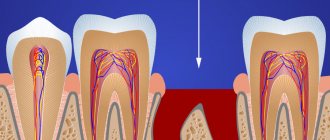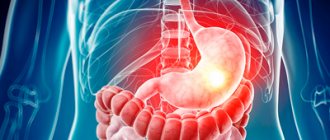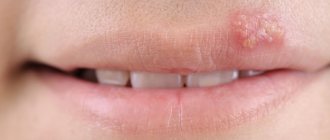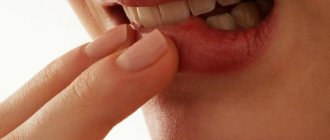Many people are familiar with the phenomenon of gumboil - when the cheek next to a sore tooth swells literally before our eyes and painkillers do not relieve acute pain. This is the periosteum of the tooth becoming inflamed, or, as doctors say, odontogenic periostitis of the jaws has developed. This disease in itself is a complication of dental problems (periodontitis, periodontitis), but in the absence of proper treatment, such inflammation can also cause the development of even more serious complications.
Why can the periosteum of a tooth become inflamed?
The most common is odontogenic periostitis of the jaws, that is, an inflammatory process provoked by diseases of the teeth or periodontal tissues. Deep caries, pulpitis, periodontitis (inflammatory process at the apex of the tooth root), periodontitis - all these diseases, if not treated in time, lead to the appearance of gumboil. Also, one of the reasons for the development of the inflammatory process may be alveolitis - inflammation of the tooth socket, which in some cases occurs after tooth extraction. Inflammation of the periosteum after tooth extraction usually develops in those patients who do not rush to see a dentist when the first signs of complications appear in the postoperative period.
Much less common is toxic periostitis, caused by infection through the blood or lymph (usually due to some general infectious disease). The disease can also be caused by injuries to the jaw bone or surrounding soft tissue.
Laser treatment
Laser excision of the hood provides better results. The main advantages include:
- lower risk of inflammatory complications, including secondary wound infection;
- coagulating effect of the laser - no risk of bleeding;
- short recovery period;
- reduction of pain after intervention;
- no need to additionally treat intervention areas with turundas and antiseptics.
There are few contraindications for laser intervention, one of them being cancer.
Inflammation of the periosteum of the tooth: symptoms
Depending on the form and localization of the process, symptoms may be as follows:
- General symptoms: severe pain in the area of inflammation, swelling, noticeable swelling, discoloration of the gums, mobility of the dental unit, which served as a source of spread of the pathological process. Depending on the location of the source of infection, facial swelling will look different: when inflammation develops near the front teeth, the upper lip or middle third of the face swells; when inflammation occurs near the chewing teeth, the cheek, sometimes the lower eyelid, and parotid area swell. You can evaluate what different types of edema look like during inflammation of the periosteum of the tooth using a photo.
- Acute serous periostitis of the lower or upper jaw is accompanied by severe redness of the mucous membranes, rapid development of edema, and increased body temperature. The general symptoms of this form of inflammation are especially pronounced.
- In the acute purulent form of the disease, severe sharp pain is characteristic, and the pain subsides under the influence of cold and becomes stronger when exposed to heat. Sleep and appetite are disturbed, the temperature rises noticeably, and the patient’s general condition worsens. Pain in most cases radiates along the branches of the corresponding nerves. For example, acute purulent periostitis of the lower jaw can make itself felt by pain in the neck, chin, ear and temporomandibular joint. Purulent periostitis of the upper jaw most often provokes pain in the orbital area, temporal bone, and ear.
- The chronic form of the disease is quite rare, and chronic periostitis of the lower jaw usually develops. The symptoms are mild, the swelling is almost unnoticeable and can gradually develop over a very long time. Pain and discomfort appear from time to time (periods of exacerbation).
At the initial stage of the inflammatory process, it usually has a serous form, later, without treatment, it becomes purulent. With a large accumulation of pus, the formed abscess can burst with the flow of purulent contents into the oral cavity. At the same time, the swelling decreases and the pain subsides. In this case, some patients calm down, believing that the problem has been solved, and are in no hurry to see a dentist. In fact, this is only temporary relief, since the pathological process can resume at any minute.
The dangers of flux and the dentist's tasks
It is the identification of such foci and their elimination, especially in persons suffering from inflammatory processes of internal organs and in pregnant women, that is one of the essential tasks of a dentist. Untimely sanitation of the oral cavity or its absence in the presence of teeth affected by chronic periodontitis can lead to the development of a number of more severe inflammatory processes, the first of which is acute purulent periostitis.
Purulent periostitis
This disease is an acute purulent inflammation of the periosteum of the alveolar process of the jaw and accounts for up to 40% of complications of odontogenic infection, mainly chronic periodontitis. The cause of the development of this disease is most often large molars, which are primarily affected by the carious process.
The clinical picture of acute purulent periostitis is diverse and depends on the nature of the microflora, localization and extent of the inflammatory process. When the upper jaw is affected, the external manifestations of acute inflammation, in particular hyperemia, infiltration and swelling of soft tissues, are usually more pronounced than when the flux is localized in the lower jaw. However, the phenomena of general intoxication are more pronounced when the alveolar process of the lower jaw is affected, which is due to the difference in the anatomical and topographic relationships of soft tissues and jaw bones.
When examining the oral cavity, smoothness or swelling of the transitional fold of the mucous membrane of the vestibule of the oral cavity, its hyperemia, and sharp pain when touched by the dentist’s hands or instruments are noticeable.
It should be borne in mind that the pain in the “causal” tooth due to the release of exudate (liquid released into the tissue or cavity of the body from small blood vessels during inflammation) beyond the periodontal gap subsides to a certain extent, but slight mobility of the tooth appears. This circumstance sometimes serves as a justification for delaying visiting a doctor and as a cause of aggravated course of the inflammatory process in the future.
The diagnosis of “acute purulent periostitis” is an absolute indication for surgical intervention in the form of opening and drainage of the periosteal purulent focus and removal of the “causal” tooth.
Options for non-drug treatment (physiotherapy) depend on the patient’s general condition, age, and concomitant chronic diseases. In the latter case, the volume and nature of drug treatment is determined by the dentist of the appropriate profile. It is especially important to carry out adequate treatment in patients suffering from rheumomyocarditis, diabetes mellitus, nephritis and some other chronic diseases.
Another complication of chronic granulating periodontitis is the development of acute odontogenic osteomyelitis , accompanied by the formation of phlegmons and abscesses of the cellular spaces of the face and neck.
These complications of flux are the most severe and dangerous result of the progression of odontogenic infection, and depending on the location and nature of the microflora, they can lead to severe complications including the development of sinus thrombosis and mediastinitis.
It is their timely diagnosis in somatic patients that largely determines the outcome of the disease.
The clinical manifestations of phlegmon are different and depend on the location of the flux (deep, superficial), the nature of the pathogen (aerobic, anaerobic flora), body resistance, concomitant diseases, age, etc.
Today, persistent, sluggish chronic necrotic processes in the bone and soft tissues of the face often occur against the background of drug addiction.
Deep phlegmons of the pterygomaxillary, infratemporal, peripharyngeal spaces are manifested by sharp pain of the corresponding localization, severe manifestations of general intoxication up to acute intoxication psychosis, severe inflammatory contracture of the masticatory muscles, pain when swallowing, with an almost complete absence of external manifestations: hyperemia, infiltration, fluctuations, etc. .
Underestimation of certain symptoms of gumboil can lead to a delay in seeking dental care, ineffective therapy and progression of the inflammatory process.
Periostitis in children
In children, the inflammatory process usually develops as a result of untreated caries of baby teeth, infectious diseases or injuries. Due to the peculiarities of the physiology and anatomy of the child’s body, as well as due to the immaturity of the child’s immune system, the pathology develops quickly and rapidly, and the infection quickly spreads through the bloodstream and lymph flow, so multiple lesions can form.
Periostitis of the upper jaw in a child requires special attention, which, when localized in the palate, may not change facial features - swelling forms inside the oral cavity and can only be noticed by the characteristic convex swelling on the palate. The abscess gradually grows, capturing the mucous areas of the pharynx and tongue, which causes pain when swallowing and chewing. If a child develops symptoms such as fever, loss of appetite, or painful swallowing, it is imperative to check whether such a condition is caused by developing gumboil.
Symptoms of pericoronitis
Pericoronitis of the tooth begins with pain in the gum area, which intensifies with pressure. You can usually notice discomfort when chewing or brushing your teeth. The gum area becomes swollen and red, and subsequently an unpleasant odor appears from the mouth.
In the absence of timely medical assistance, other manifestations also occur:
- spread of pain radiating to the ear, temple;
- difficulty swallowing, sore throat;
- speech difficulties;
- limitation of mouth opening due to swelling of the peripharyngeal area;
- enlarged lymph nodes;
- low-grade fever;
- swelling of the cheek due to inflammation.
A person experiences difficulty chewing food and may suffer from a general deterioration in health and headaches.
Symptoms may subside after some time, which means that the disease has entered a chronic stage. Purulent complications may also occur, and if a passage opens in the gum to remove purulent contents, the acute pain goes away. However, the inflammatory process persists.
Possible complications and diagnosis
If the disease is not treated properly, very serious complications soon develop: osteomyelitis (purulent inflammation of bone tissue, provoking its necrosis), phlegmon (a diffuse purulent process that affects nearby tissues and requires immediate surgical intervention), sepsis (a general infection of the body, often ending in the death of the patient ). Each of these conditions requires emergency medical care and long, painstaking treatment. Therefore, it is better not to let the situation lead to complications and contact a dentist at the first signs of an inflammatory process.
To establish an accurate diagnosis, the doctor will need to conduct a differential diagnosis using instrumental diagnostic methods (radiography, CT). This disease is similar in symptoms to acute periodontitis, acute inflammation of the salivary glands, lymphadenitis, and osteomyelitis. Therefore, in order to prescribe adequate treatment, it will be necessary to exclude these conditions and accurately determine the cause of the patient’s poor health.
What are the main treatments for cheek swelling?
The ATLANTIS DENTAL medical center has created ideal conditions for the diagnosis and treatment of dental diseases of any complexity. If you find that your cheek is swollen, you should urgently visit a doctor. Experienced therapists and surgeons will quickly and painlessly eliminate the problem, which will avoid unwanted complications.
- During the consultation, the doctor collects anamnesis, performs a dental examination, and prescribes diagnostic measures (x-rays, CT scans, blood tests, etc.).
- If necessary, the patient is referred for consultation to specialized specialists: neurologist, otolaryngologist, endocrinologist, etc.
- Based on the results of the examination, a treatment regimen is determined.
- When cystic neoplasms, pulpitis and inflammation of the periosteum are detected, surgical intervention is necessary.
- It may also be necessary to remove the tooth or refill the canals.
Good results are shown by treatment with antibacterial drugs, rinsing the mouth with antiseptics and applying dental gels to the affected areas.
Inflammation of the periosteum of the tooth: treatment
Periostitis of the lower and upper jaw requires almost the same treatment, despite some differences in symptoms and localization of lesions. Moreover, complex therapy will be required, which will quickly eliminate the infectious-inflammatory focus and prevent relapses:
- Surgery. Opening the purulent sac with removal of the contents and thorough cleaning of residual pus is a mandatory procedure in this case. The intervention is performed under local anesthesia. At the initial stage of the disease (with its serous form), it is possible to do without surgical intervention. In this case, the doctor carries out endodontic treatment (depulpation, cleaning and treatment of root canals, antibacterial therapy).
- Drug therapy. Prescribing antibacterial and anti-inflammatory drugs to eliminate inflammatory phenomena (swelling, hyperemia, fever, pain) and infection.
- Physiotherapeutic procedures. Iontophoresis, ultrasound or laser therapy, electrophoresis, paraffin therapy - all these procedures are usually aimed at resolving compactions formed as a result of the pathological process. As a rule, physiotherapy is used for chronic forms of the disease, but in some cases it can be used in the complex treatment of acute purulent forms.
Antibiotics for inflammation of the periosteum of the tooth are prescribed during the treatment process; they are necessary to eliminate the bacterial infection, which is one of the causes of the development of the purulent-inflammatory process. The doctor selects medications based on the severity of the disease, the general condition of the patient’s body and the possible presence of concomitant diseases. Along with antibiotics for periostitis of the jaw, antihistamines (antiallergic) are also prescribed as treatment, which can reduce the drug load on the immune system, as well as calcium supplements.
The success of treatment largely depends on the patient’s timely visit to the doctor and the effectiveness of the therapy itself. And if in the first case everything depends on the patient - his conscious attitude towards his own health, then in the second the success of treatment is completely determined by the qualifications and experience of the dentist to whom the patient turned. A competent specialist with extensive clinical experience will quickly and successfully cope with even such a complex disease, while an amateur can further aggravate the problem. Therefore, choosing a good specialist is important here - these are the specialists who work at the 32 Dent clinic. Our doctors have extensive experience in successfully treating any purulent-inflammatory diseases of the oral cavity, including periostitis.
Types and symptoms of gingivitis
Gingivitis of teeth.
Gingivitis is not a specific disease, but rather the name of a whole group of inflammatory gum diseases. And the symptoms will depend on the type of disease.
Catarrhal gingivitis
The most common form that occurs most often in patients. It is relatively safe, is not accompanied by serious changes in the gum tissue and sometimes even occurs in a chronic form, asymptomatically. During exacerbation, catarrhal gingivitis is characterized by the following symptoms:
- Sore and bleeding gums.
- Itching sensation.
- Redness and swelling of the gum edge.
- Swelling, inflammation of the gingival papillae.
The general health of this form does not deteriorate, the gums do not change too much in appearance, the teeth do not become loose, and periodontal pockets do not form. The disease can remain in this stage for a long time and manifest itself only periodically, during brushing of teeth or during periods of weakening of the body, for example, due to illness.
But over time, if the disease is not treated, it can develop into another form of gingivitis or periodontitis.
Hypertrophic gingivitis
The main feature of this disease is that the gums do not just swell, but grow, significantly creep onto the teeth and increase in size. It is also characterized by other symptoms:
- Severe pain and swelling of the gums with relatively mild bleeding.
- Gradually the gums become enlarged and overgrown, and pain increases.
- The gums do not become loose, but rather harden, and plaque and stone form underneath, which is very difficult to remove.
This form of gingivitis greatly affects the aesthetics of a smile and can be quite painful, but it rarely progresses to other types or diseases.
Ulcerative-necrotizing gingivitis
This is a fairly serious inflammation of the gums, in which an acute inflammatory process occurs in the tissues, and over time they even begin to die. The following symptoms are typical for this type of gingivitis:
- Severe bleeding and pain even when at rest, not while brushing your teeth.
- The gums practically do not swell and do not increase in size.
- White, painful ulcers appear on the gums, tongue and inner cheeks.
- Body temperature often rises, general health worsens, and lymph nodes enlarge. Sometimes headaches occur.
This form usually occurs if the body is very weakened, for example with diabetes. It causes the most problems and can cause an abscess and even blood poisoning. With this form there is usually no remission - the ulcers simply spread slowly, and this is accompanied by constant pain and bleeding.
Atrophic gingivitis
This type of disease is most often associated not with external, but with internal problems of the body. With it there is no redness of the gums, no bleeding, no deterioration in general health, sometimes there is not even pain. The disease can be recognized by the following symptoms:
- Reduced gum size - the tissue atrophies, making the teeth appear visually longer.
- Exposure of the necks of the roots of the teeth - in the lower part, yellowed areas without enamel are visible, not shiny and rough to the touch.
- A painful reaction to cold, hot and spicy food appears, and brushing your teeth becomes uncomfortable.
This type of gingivitis may not cause any discomfort for a long time, but it is especially dangerous since it will be very difficult to restore the disappeared gum tissue. In addition, this form of gingivitis often leads to periodontitis.
How to treat inflammation of the periosteum of a tooth before visiting a doctor?
Self-medication for any purulent processes is very dangerous, so it is recommended to consult a dentist at the first symptoms of the disease. However, before visiting a doctor, the patient can alleviate his condition somewhat by applying cold to the cheek on the affected side and rinsing his mouth with an antiseptic solution at room temperature (chlorhexidine soda-saline solution, chamomile or sage decoctions). Here's what you absolutely can't do:
- Apply warm compresses and drink hot drinks.
- Apply any bandages yourself or use medications without a doctor’s prescription.
- It is better not to take analgesics before visiting the dentist.
- If you are undergoing surgery (opening an abscess), you should not take aspirin, since it changes the rheological properties of the blood and can cause bleeding.
How to relieve the condition at home?
To alleviate the condition before visiting a doctor, you can relieve pain and reduce swelling of the cheek with home remedies.
- A pronounced anti-inflammatory effect is exerted by rinsing infusions made from oak bark or calendula, chamomile, and sage inflorescences. To prepare the solution, two tablespoons of raw material are steamed with boiling water and infused for 15-30 minutes, after which rinsing is carried out three to four times a day.
- The soda-salt solution effectively relieves pain, reduces swelling and has a pronounced antiseptic effect. To do this, the components in the amount of 15 g (1 tsp) are stirred in a glass of warm water and used for their intended purpose.
- Dental ointments and gels, which are applied by application to the affected area 2-3 times a day, have proven themselves well.
- Pharmacy antiseptics are always effective, regardless of the causes of swelling of the cheek and gum tissue. Among the most popular: Chlorhexidine, Miramistin, Furacilin, hydrogen peroxide.
If your health worsens and you suspect an allergy, you need to take antihistamines, such as: Tavegil, Zodak, Suprastin, Kestin, etc. To relieve pain, take analgesics or NSAIDs - non-steroidal anti-inflammatory drugs.
Important! In case of severe swelling of the cheek, “tugging” pain, high body temperature and respiratory dysfunction, urgent hospitalization is necessary. Symptoms may indicate anaphylactic shock or sepsis.
My gums hurt after filling a tooth, what should I do?
If, after installing a filling, your gums are very sore and even your cheek is swollen, you cannot do without the help of a dentist. Moreover, it is necessary to contact as soon as possible so that there are no even more unpleasant consequences.
A few tips to relieve pain:
- applying an ice compress to the cheek at the sore spot for several minutes or a compress with ice cubes;
- alternate application of compresses with warm rinses from decoctions of medicinal herbs or infusions;
- painkillers.
Attention! Under no circumstances should you apply hot or warm compresses - they actively provoke inflammation and pain!
Taking antibiotics without a doctor's prescription is also extremely contraindicated, because this can lead to a decrease in immunity and complicate further treatment.
Preventive measures
After filling a tooth, during the first week, you must strictly follow the main rules so that pain does not occur, or it disappears as soon as possible:
- do not drink or eat too cold or too hot, as temperature changes provoke pain;
- every time after eating, brush your teeth and rinse your mouth with special anesthetic rinses (the ASEPTA series includes rinses with an analgesic and disinfecting effect);
- try to eat softer foods so as not to damage the periodontal tissues, and it is preferable to chew only on the healthy side;
- do not smoke, as the tooth disturbed by treatment is very sensitive in the first days.











